Figure 2.
Collective migration of epithelial cells and mesenchymal cells. Epithelial migration can arise from an unjamming transition of quiescent epithelial sheets. Such unjammed, motile epithelia display packs of collectively migrating cells (purple cells), while maintaining strong intercellular junctions (dark brown rectangles) and epithelial markers, such as E-cadherin. Epithelial migration is also evident in wound healing. Leader cells tend to form large forward-facing protrusions, with follower cells also contributing significant traction forces to move the sheet forward (teal rectangles). Mesenchymal migration can arise from an epithelial-to-mesenchymal transition, in which cells (green cells) lose apicobasal polarity in favour of front-rear polarity, and intercellular adhesions become weaker and more transient (light brown rectangles), which is associated with a change in gene expression, such as E-cadherin being replaced by N-cadherin. Whereas leader cells form strong focal adhesions, follower cells do not. The black arrow indicates the direction of migration.

